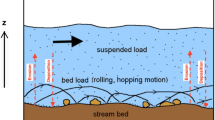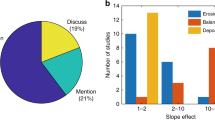Abstract
Process-based numerical modelling of coastal morphodynamics involves model and data reduction schemes in order to cope with computational limitations. Model reduction, on the one hand, may involve the discretisation of an interactive multidimensional, diverse natural system into a reduced set of coupled process-simulation modules. Data reduction schemes, on the other hand, are used to parameterise processes. The use of schematised open-boundary conditions, which are considered as representative in terms of their cumulative morphological effect, is based on the concept of “morphological” or “representative” boundary conditions. Recent model applications show realistic tendencies in terms of depositional and erosional areas. By contrast, the reproduction of characteristic changes in morphology such as the migration of bars, banks and channels is only occasionally achieved. Using field data on observed morphological impact of a single storm event and numerical model data, it is demonstrated that the concept of representative tides may lead to simulations of morphological development lacking natural dynamics. It is proposed that rather than being based on “representative” single tides, morphodynamic models should be applied with open-boundary conditions which take variations in longer-term tidal and meteorological forcing into account.







Similar content being viewed by others
References
Axer T, Bistry T, Faust E, Fietze S, Müller M, Prechtl M (2005) Sturmdokumentation Deutschland. Rep Deutsche Rückversicherung, Düsseldorf
Cayocca F (2001) Long-term morphological modeling of a tidal inlet: the Arcachon Basin, France. Coastal Eng 42:115–142
Davies AG, van Rijn LC, Damgaard JS, van de Graaff J, Ribberink JS (2002) Intercomparison of research and practical sand transport models. Coastal Eng 46:1–23
de Vriend HJ, Zyserman J, Nicholson J, Roelvink JA, Pechon P, Southgate HN (1993) Medium-term 2DH coastal area modelling. Coastal Eng 21:193–224
Diesing M, Kubicki A, Winter C, Schwarzer K (2006) Decadal scale stability of sorted bedforms, German Bight, south-eastern North Sea. Cont Shelf Res 26(8):902–916
Egbert GD, Bennett AF, Foreman MGG (1994) TOPEX/POSEIDON tides estimated using a global inverse model. J Geophys Res 99(C12):24821–24852
Grunnet NM, Walstra DJR, Ruessink BG (2004) Process-based modelling of a shoreface nourishment. Coastal Eng 51:581–607
Hirschhäuser T, Zanke U (2002) Morphologische Langfristprognose für das System Tidebecken-Außensände am Beispiel Sylts und der Dithmarscher Bucht. Die Küste 64:127–160
Hirschhäuser T, Mewis P, Zanke U (2001) Modelling accumulation of fine grained material in the Hörnum tidal-basin using representative wave situations. In: Proc Annu Conf IAMG 2001, 6–12 September 2001, Cancun, Mexico. International Association for Mathematical Geology, Kingston, ON, Canada
Kleine E (1994) Das operationelle Modell des BSH für Nordsee und Ostsee. Tech Rep Bundesamt für Seeschifffahrt und Hydrografie, Hamburg
Latteux B (1995) Techniques for long-term morphological simulation under tidal action. Mar Geol 126:129–141
Lesser GR, Roelvink JA, van Kester JATM, Stelling GS (2004) Development and validation of a three-dimensional morphological model. Coastal Eng 51:883–915
Mason DC, Garg PK (2001) Morphodynamic modelling of intertidal sediment transport in Morecambe Bay. Estuarine Coastal Shelf Sci 53:79–92
Roelvink JA (2006) Coastal morphodynamic evolution techniques. Coastal Eng 53:277–287
Roelvink JA, van Banning GKFM (1994) Design and development of DELFT3D and application to coastal morphodynamics. In: Verwey A, Minns AW, Babovic M (eds) Proc Int Conf Hydroinformatics’94, 19–23 September 1994, Delft. Balkema, Rotterdam, pp 451–456
Smith WHF, Sandwell DT (1997) Global sea floor topography from satellite altimetry and ship depth soundings. Science 277:1956–1962
Wilkens J (2001) Medium-scale morphodynamic modelling in the Meldorf Bight. In: Phelps D, Sehlke G (eds) Proc world water & environmental resources congr, 20–24 May 2001, Orlando, Florida. American Society of Civil Engineers, Reston, Virginia
Winter C (2002) Zur morphodynamischen Modellierung am Beispiel der Tideeider. Dissertation, Kiel University, Germany
Winter C (2006) Meso-scale morphodynamics of the Eider Estuary: analysis and numerical modelling. J Coastal Res Spec Issue 39 (in press)
Winter C, Bartholomä A (2006) “Coastal dynamics and human impact: south-eastern North Sea”, an overview. In: Bartholomä A, Winter C (eds) Coastal dynamics and human impact: south-eastern North Sea. Geo-Mar Lett 26(3) (in press)
Winter C, Mayerle R (2003) Calibration of a sediment transport model using field measurements. In: Davis RA, Sallenger A, Howd P (eds) Proc int symp coastal sediments 2003, 18–23 May 2003, Clearwater Beach, Florida. World Scientific, Hackensack, New Jersey
Winter C, Hoyme H, Poerbandono, Mayerle R (2006) Numerical modelling of suspended sediment dynamics in tidal channels of the South Eastern German Bight. Die Küste 69 (in press)
Wyatt LR, Green JJ, Gurgel KW, Nieto Borge JC, Reichert K, Hessner K, Gunther H, Rosenthal W, Saetra O, Reistad M (2003) Validation and intercomparisons of wave measurements and models during the EuroROSE experiments. Coastal Eng 48:1–28
Acknowledgements
The authors thank the following German authorities for providing field data: annual bathymetric data were obtained from the Federal Shipping and Hydrographic Office (BSH), Hamburg, and water-level data from the Waterways and Shipping Office (WSA), Cuxhaven. We are grateful to the captain and crew of the RV Ludwig Prandtl for their technical support and Martina Heineke for the processing of multibeam data. This study was funded by the Deutsche Forschungsgemeinschaft as part of the DFG Research Center Ocean Margins (RCOM) at the University of Bremen, Germany.
Author information
Authors and Affiliations
Corresponding author
Rights and permissions
About this article
Cite this article
Winter, C., Da Chiou, M., Riethmüller, R. et al. The concept of “representative tides” in morphodynamic numerical modelling. Geo-Mar Lett 26, 125–132 (2006). https://doi.org/10.1007/s00367-006-0031-5
Received:
Accepted:
Published:
Issue Date:
DOI: https://doi.org/10.1007/s00367-006-0031-5




